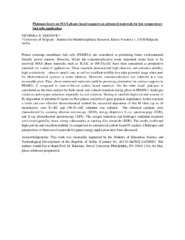Prikaz osnovnih podataka o dokumentu
Platinum layers on MAX phases based supports as advanced materials for low temperature fuel cells application
| dc.creator | Elezović, Nevenka R. | |
| dc.date.accessioned | 2023-11-25T15:19:54Z | |
| dc.date.available | 2023-11-25T15:19:54Z | |
| dc.date.issued | 2022 | |
| dc.identifier.uri | http://rimsi.imsi.bg.ac.rs/handle/123456789/2332 | |
| dc.description.abstract | Platinum layers on MAX phases based supports as advanced materials for low temperature fuel cells application NEVENKA R. ELEZOVIC* *University of Belgrade - Institute for Multidisciplinary Research, Kneza Viseslava 1, 11030 Belgrade, Serbia Proton exchange membrane fuel cells (PEMFCs) are considered as promising future environmental friendly power sources. However, before the commercialization some important issues have to be resolved. MAX phase materials, such as Ti2AlC or (Nb-Ti)2AlC have been considered as perspective materials for variety of applications. These materials demonstrated high chemical and corrosion stability, high conductivity – close to metals′ one, as well as excellent stability in a wide potential range when used for electrochemical systems in water solutions. Moreover, commercialization was achieved at a very reasonable price. Thus, above mentioned materials could be promising alternative for catalyst supports in PEMFCs if compared to state-of-the-art carbon based materials. On the other hand, platinum is considered as the best catalyst for both anode and cathode reactions taking place in PEMFCs: hydrogen oxidation and oxygen reduction, especially in acid solutions. Having in mind the high cost and scarcity of Pt, deposition of ultrathin Pt layers on Max phases could be of great practical importance. In this research a facile and cost effective electrochemical method for successful deposition of thin Pt films (up to 10 monolayers) onto Ti2AlC and (Nb-Ti)2AlC substrate was referred. The obtained catalysts were characterized by scanning electron microscopy (SEM), energy dispersive X-ray spectroscpopy (EDS), and X-ray photoelectron spectroscopy (XPS). The oxygen reduction and hydrogen oxidation reactions were investigated by linear sweep voltammetry at rotating disc electrode (RDE). The results confirmed high activity and excellent stability in comparison to commercial carbon based Pt catalyst. Challenges and perspectives of these novel materials for green energy application have been discussed. Acknowledgements: This work was financially supported by the Ministry of Education, Science and Technological Development of the Republic of Serbia (Contract No. 451-03-68/2022-14/200053. The authors would like to thank Prof. M. Barsoum, Drexel University Philadelphia, PA 19104 USA, for Max phase substrates preparation. | sr |
| dc.language.iso | en | sr |
| dc.publisher | Pangea Global Events 16192 Coastal Highway, Lewes, Delaware 19958-9776 | sr |
| dc.relation | info:eu-repo/grantAgreement/MESTD/inst-2020/200053/RS// | sr |
| dc.rights | openAccess | sr |
| dc.source | , Global Conference on Materials Science and Engineering | sr |
| dc.subject | Platinum layers | sr |
| dc.subject | MAX phases | sr |
| dc.subject | oxygen reduction | sr |
| dc.subject | hydrogen oxidation | sr |
| dc.subject | green energy | sr |
| dc.title | Platinum layers on MAX phases based supports as advanced materials for low temperature fuel cells application | sr |
| dc.type | lecture | sr |
| dc.rights.license | ARR | sr |
| dc.identifier.fulltext | http://rimsi.imsi.bg.ac.rs/bitstream/id/6077/bitstream_6077.pdf | |
| dc.identifier.fulltext | http://rimsi.imsi.bg.ac.rs/bitstream/id/6078/bitstream_6078.pdf | |
| dc.identifier.rcub | https://hdl.handle.net/21.15107/rcub_rimsi_2332 | |
| dc.type.version | acceptedVersion | sr |


